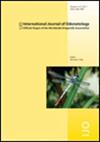形态学和分子证据支持意大利特有种Coenagrion castellani Roberts的物种地位,1948 (Coenagrion castellani Roberts)
IF 1
4区 农林科学
Q3 ENTOMOLOGY
引用次数: 0
摘要
Coenagrion castellani Roberts, 1948,大约75年前在意大利被描述为一个独特的物种,但通常没有被承认或被视为C. mercurale的亚种(Charpentier, 1840)。最近的研究表明,阿尔卑斯山以南的人口在基因上与北非和欧洲其他地方的人口完全隔离。由于斑纹和雄性附属物也允许在野外容易分离,因此castellani最好被视为一种好物种,是欧洲已知的第146种,意大利特有的第二种。对其识别和发生进行了综述。北非人口在基因上也不同,但在形态上却不同。是否应将其作为一个独立的分类单元,如亚种C. mercurale hermeticum (Selys, 1872),需要进一步研究。本文章由计算机程序翻译,如有差异,请以英文原文为准。
Morphological and molecular evidence supports the species status of the Italian endemic Coenagrion castellani Roberts, 1948 (Coenagrionidae)
Coenagrion castellani Roberts, 1948 was described from Italy as a distinct species almost 75 years ago but has generally not been recognised or was treated as a subspecies of C. mercuriale (Charpentier, 1840). Populations south of the Alps were recently shown to be completely isolated genetically from those in North Africa and elsewhere in Europe. As markings and male appendages also allow for easy separation in the field, C. castellani is best treated as a good species, the 146th odonate species known from Europe and the second one that is endemic to Italy. Its identification and occurrence are reviewed. North African populations are distinct genetically too, but not in morphology. Whether these should be treated as a distinct taxon, e.g. as the subspecies C. mercuriale hermeticum (Selys, 1872), requires further research.
求助全文
通过发布文献求助,成功后即可免费获取论文全文。
去求助
来源期刊

International Journal of Odonatology
ENTOMOLOGY-
CiteScore
2.30
自引率
0.00%
发文量
15
审稿时长
>12 weeks
期刊介绍:
International Journal of Odonatology (IJO) is aimed at providing a publication outlet for the growing number of students of Odonata. It will address subjects such as the ecology, ethology, physiology, genetics, taxonomy, phylogeny and geographic distribution of species. Reviews will be by invitation, but authors who plan to write a review on a subject of interest to the journal are encouraged to contact the editor.
 求助内容:
求助内容: 应助结果提醒方式:
应助结果提醒方式:


